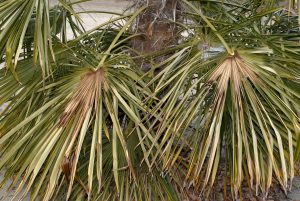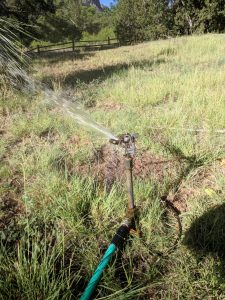The dog days of summer are here and as we approach the longest day of the year (summer solstice is June 21st), we are also feeling the advance of high summer temperatures. Long days mean more evapotranspiration and water withdrawal from the soil. During these long days, plants photosynthesize more, grow more, and use the most water during the month of June. In fact evapotranspiration looks generally looks like a bell shaped curve when plotted by month (figure 1). Soils dry quickly and irrigation or rainfall may not keep

up with plant demands for water. This can bring some very real stress to garden plants and turfgrasses. If you live in a place that does not receive summer rainfall you will certainly need to increase irrigation to reflect day length at this time of year.
Transpiration is water loss through leaves and is not part of photosynthesis, but it is critical to cool the plant. As soils dry out, the level of abscisic acid produced in roots increases and translocates to leaves resulting in the closing of the pores called stomates. Closed stomata reduces transpiration, but only at a steep cost to the plant. That cost is heat build up. Since this is also the time of the hottest weather it is not long before leaf temperatures rise to lethal levels and sunburn results. Sunburn is always seen as damage in the middle of the leaf because that is the hardest spot to dissipate the heat. The edges that lose heat rapidly are usu

ally not burnt (Figure 2).
Short of applying water properly, what else can be done? Mulches are a great way to avert drought stress since they reduce water loss from the soil surface. The effect is greatest where sun hits the soil. So in new gardens or gardens without a lot of shade, mulches are essential during hot weather to reduce plant stress. Wood chip mulches are particularly helpful in that wood does not reflect, hold or emit heat as much as soil, so it protects adjacent plant surfaces from heat.
How about water absorbing polymers or hydrogels? While much of the allure of these “water crystals” has worn off, it is still good to remind that polymers don’t change evapotranspiration rates of plants so even if they did all the things they claim to, they won’t get plants through a hot summer any better than if they were not present in the soil.
With the longest days come warming soil temperatures. Hot soil can affect plants especially perennials. Ground that is not mulched will radiate infrared onto plant surfaces, this can increase stress. This is yet another reason to employ wood chip mulches around perennials.

So when it is particularly hot and dry how can we get plants through this stressful time? Running sprinklers (where practical) will increase humidity and if soils are dry reduce stress (Figure 3). For annual plants, some shade is often helpful. Applying shade cloth to sensitive or newly planted/emerged plants can cut stress dramatically. As plants establish, the shade can be gradually removed. Keep irrigation even so moisture is always there to maintain transpiration — this is essential during warm weather and long days. For perennial plants there is not much to be done. While pruning will reduce the amount of surfaces that lose water, pruning (thinning) will also lead to temperature increases in the plant canopy since the evaporative surface area of the plant is decreased. So while soil water is saved, canopy temperatures may rise, this may be a poor trade off in the hottest months of the year. Over-pruning opens plants up for sunburn on stems which can lead to fungal canker infections by pathogens like Botryosphaeria. This is very common in Apples.
Another treatment you may have heard claims for are anti-transpirants. These are products that are sprayed on plants to create a film that will cut water loss from leaves. Taken from a recent Amazon search I found the following product description recently… “Product is a water-based, semi-permeable polymer coating that can minimize the damages from climate related stresses, such as frost and freeze, heat stress and sunburn, drying winds, and transplant shock. Applied as a foliar spray, Product provides a unique non-toxic, biodegradable, elastic membrane over the plant surface to reduce moisture loss and insulate the plant.” While there may be an application (such as freeze protection) that makes sense for this kind of product somewhere, I don’t see it in your garden during hot weather. Cutting transpiration (“reducing moisture loss”) will increase the heat on leaves, so one of the common side effects of using these products is hot weather is damage or phytotoxicity. Like polymers the fad is faded.
Sometimes the dog days of summer bring insurmountable challenges. In early summer of 2018 in California, temperatures reached record levels of 115-120. Even in irrigated situations plants were damaged, short of providing immediate shade, there was nothing to be done and many plants were injured, even native plants are not adapted to such high temperatures. If these conditions occur in your garden, you may not be able to limit damage, but there are considerations for after care when this kind of blitz occurs. Don’t prune anything immediately, let the leaves fall and buds form because stems may be intact. Prune away injured plant parts after regrowth begins. If injury is severe, cut back on irrigation. Injured plants don’t require as much water because there is less functional leaf area. This is why root root rot often follows this sort of severe injury. The summer solstice is here—I can already feel the shortening days of fall some distance away.
Reference
Costello, L.R., E.J. Perry, N. P. Matheny, M.J. Henry, and P.M. Geisel. 2014. Abiotic disorders of Landscape Plants. University of California Division of Agriculture and Natural Resources Publication #3420.
I’ve been operating under the impression that damage to foliage from heat stress and sunburn (photooxidation) are two different things, with the former occurring when high ambient temperatures + passive solar gain + the insulating effect of the boundary layer surrounding leaves work in concert to raise leaf temperatures to damaging levels; while the later, sunburn/photo-oxidation, can occur at even low leaf temperatures as a result of the light-induced free radicals that oxidize plant tissues. Where did I go wrong?
They are two separate things on a cellular level. High temperatures lead to water stress in the leaf, causing tip and marginal necrosis. Sunburn is the result of chloroplasts absorbing more photo-energy than they can funnel into work, resulting in oxidative stress and bleaching of tissues. Usually this happens on the surface, not the edges.
Practically speaking, both can happen at the same time but the mechanism is different.